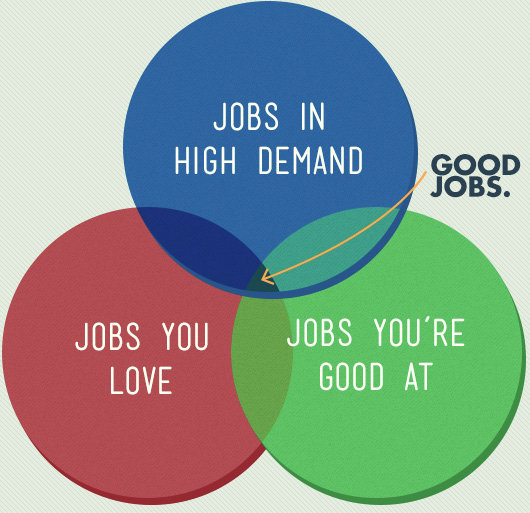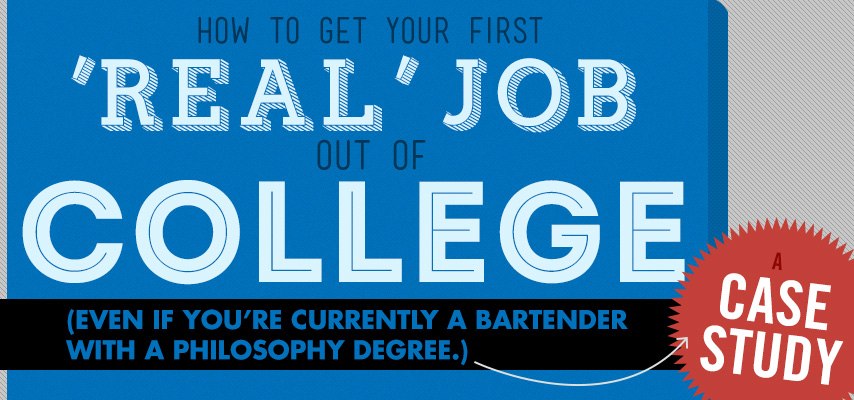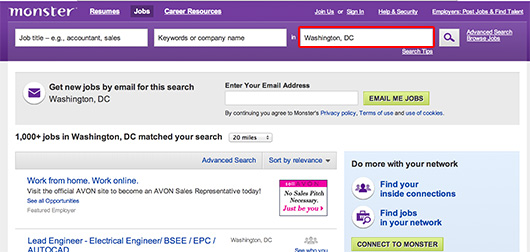By Matt Goldenberg
Case Study –
“Do what you love and the money will follow.”
That’s the lie you were told that led to your liberal arts major — and eventually that dead end job at a coffee shop, restaurant, or bar.
It’s not that you’re not smart, capable, or motivated. It’s that no one will give you a chance. It seems no one will hire you without experience…and you can’t get experience without anyone hiring you.
That’s the predicament that Justin Marshall was in when we first started working together. A philosophy major working part time as a bartender, he was fed up with the irregular hours and thinking about going back for a PhD simply because he didn’t see an alternative.
One year later, Justin is the operations manager for a high-end restaurant group in DC, the social media manager for a hot web series, and makes extra money on the side as a social media consultant.
It turns out career miracles are possible. All you need is the right technique.
How to Work Career Miracles – The Skill Bridge Technique
The turning point for Justin was when he realized that you can change the course of your career with one job title. All he had to do was figure out some way to get that first job, and he would change the course of his entire career. The trick was convincing his boss that a promotion was not only called for, but in the boss’s—and the company’s—best interest.
job title.
- Justin researched what skills and job title he wanted.
- He figured out the problems, challenges, and opportunities that were present at his workplace.
- Finally, he made a document that bridged the skills he wanted with the problems that his boss was encountering. This convinced his boss to give him his new job title.
Let’s unpack this and look at exactly what Justin did at each step in the process.
Step 1 – How to Figure out What Skills and Job Title You Want
One of the unconscious assumptions that Justin held was that if he was good at his job and he loved doing it, it qualified as a good job. However, it turns out that by only using these two criteria, he discovered a lot of jobs with low pay, limited options, and horrible hours In order to find the actual “good jobs,” he needed to not only think about jobs he loved, but jobs that were in high demand.

The natural impulse that Justin had was to simply create a list of jobs that he imagined would lead to fulfilling all three criteria.
However, this led to a lot of guessing and rationalizing, instead of actually finding jobs he would enjoy, was good at, and were in high demand. Ultimately, he realized that he had to tackle each category individually.
Finding Jobs in High Demand
The first step was to find what jobs were in high demand. To do this, Justin simply went to job listing sites like Monster.com, and entered in his city into the search box. Any time he found a job title that looked interesting—and was mentioned multiple times—he added it to his list of potential careers. This step alone changed Justin’s thinking completely. He ended up with some interesting titles, like Community Manager, Data Analyst, and Technical Writer.
Finding Jobs You’re Good At
The next step was to take the list of jobs that were in high demand, and find out which ones he would be good at. To do this, Justin used websites like Pace Careers and Onet Online that give detailed descriptions of what duties jobs require and what types of people would be good at them. This allowed him to narrow down his list to only those jobs which he would be good at. He tended towards jobs that involved heavy strategy, writing, and interacting with people.
Finding Jobs You’ll Love
The last step was to narrow down his list to the jobs he thought he would love. Rather than trying to imagine this, Justin realized that the best way to discover if a job would be enjoyable was to talk to people who had that job.
In order to do this, Justin searched LinkedIn to find people nearby him who had similar job titles to what he was looking for. He then messaged them and asked if they would be willing to meet for coffee.
This allowed him to ask simple questions like:
- What does a typical day look like?
- What was most surprising about your job?
- If you only had two weeks to learn your job, what skills would you learn?
- What’s the most important part of your job?
Using these questions, Justin could not only discover if he would enjoy the job, but also the minimum skillset that he would need to learn in order to be effective. He ultimately decided that Community Manager was the job title he would explore first.
Step 2 – How to Figure Out the Problems, Challenges, and Opportunities at Your Workplace
Justin knew that simply presenting a list of skills such as “Post viral tweets to twitter” to his boss wasn’t likely to do much. He came to realize that his boss didn’t care what skills Justin had, but just cared about what problems Justin could solve.
In order to help Justin brainstorm, we used three key areas that are problems, challenges, or opportunities for nearly every boss: emotions, money, and relationships.
 Emotions
Emotions
He knew that the promise to make someone feel better is a powerful motivator, so Justin asked himself a few simple questions:
- How can I reduce my boss’s stress?
- How can I remove his boredom?
- How can I increase his excitement?
Justin ultimately identified a few emotions, but figured that he would mainly focus on other levers.
Money
Justin knew that if he could tangibly affect the bottom line, this would be a large incentive to promote him. In order to do this, there was only two things he needed to be able to do.
- Cut costs
- Increase revenue
Justin unearthed several areas where he could either cut costs or increase revenue. For example:
- Converting occasional customers to regular customers
- Avoid losing customers
- Increase lucrative events
- Determine return on investment
Relationships
Finally, Justin looked at relationships. Could he:
- Increase his boss's status?
- Improve employee relations?
- build the restaurant’s brand?
He found several instances in which social media was actually damaging the reputation of the restaurant and its owner, and established that he could indeed affect relationships.
Step 3 – How to Create a Document That Bridges Your Skills with the Problems
Finally, Justin sat down to create a document that would convince his boss that the skillset he planned to learn would help solve the problems, challenges, and opportunities that he identified. He was able to demonstrate just enough credibility through the lingo he had picked up in his informational interviews, and was confident that he could execute on the plan based on the minimum skillset he had mapped out.
The only hurdle left was convincing his boss that it was worthwhile, so Justin focused on three principles: selling benefits over details, getting to the point, and getting to yes.
Selling Benefits over Details
After learning so much about being a Community Manager, Justin was eager to show off the details of his plan. However, his boss only cared about the benefits to business. We made sure to cut off all of the implementation details that weren’t directly relevant, and tied every bullet point in the proposal to a measurable outcome from step two (How to Figure out The Problems, Challenges, and Opportunities at Your Workplace).
Getting to the Point
The document that Justin created was not a strategy document. It wasn’t meant to detail every aspect of his plan. It was meant for one thing: to convince his boss to give him the job title. We ruthlessly cut down and edited the proposal until it included only those points which would build to a solid yes.
Getting to Yes
Finally, Justin never lost sight of his goal: to change the course of his career with one job title. He negotiated hard, but never so hard that it would put that goal in jeopardy. He remembered to be more concerned with the job title and skills he would be using than the exact details about hours and pay. He knew that simply getting to yes was more important than all the exact details about that yes.
The Result
Ultimately, Justin got to yes. He received the title he wanted, he learned the skills he needed, and he also managed to double his salary in the process. And it wasn’t just that one job; Justin changed the course of his entire career, and opened up the opportunities that have led him to where he is today. View this post not as a simple case study, but as an action guide to implementing the skill bridge technique. What career miracles can you create?
Interested in seeing the exact document that Justin used, an in-depth interview with Justin, and more? Click Here.
Matt Goldenberg is the founder of Self-Made Renegade, a website that helps liberal arts grads and career changers get any job, in any field, without the right degree, connections, or experience.







 Emotions
Emotions










